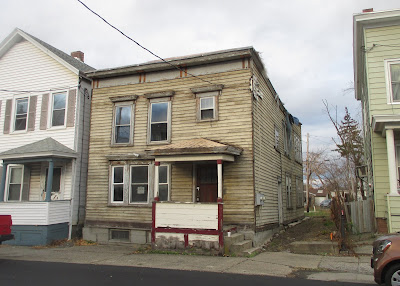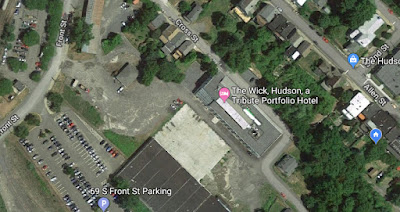The former ShopRite building continues to stand empty (when last we heard, it was on the market for $12,750,000 and, alternatively, it was available for lease) and most of the shops in Fairview Plaza are vacant, but TRG (Trinity Realty Group) is moving ahead undeterred with its plans to create a new retail development for Aldi's, McDonald's, and two more so far unknown retail establishments (do we need another dollar store or another source for automotive parts?) on the site of the current the McDonald's on Fairview Avenue at Healy Boulevard. On Tuesday night, the Greenport Planning Board continued its review of the project and held a public hearing.
Before the public hearing began, Robert MacGiffert, who was sitting in for Planning Board chair Ed Stiffler, reviewed the potential impacts identified in Part 2 of SEQR Environmental Assessment Form and the plans for mitigation. Of the eighteen potential impacts, seven had been identified:
- Impacts on Land--There will be retaining walls along the wetland.
- Impacts on Surface Water--A storm water management plan addresses this.
- Impact on Plants and Animals--There are two endangered species in the area: the northern long-eared bat and the Indiana bat. Harm to the bats will be mitigated by removing trees during a designated time frame, when the action presumably will not impact the bats. There are barn owls--a rare species--living in the Farrand House. To avoid harm to the owls, the house will be opened to allow the owls to leave before it is demolished.
- Impact on Historic and Archeological Resources--The plan involves the demolition of the Farrand House, which the State Historic Preservation Office (SHPO) has determined to be eligible for listing in the state and national registers of historic places. SHPO's conditions for demolishing the building will be met: (a) the building will be documented; (b) a public exhibit depicting the history of the building and site will be located on the site; (c) building elements will be offered to a local non-profit architectural salvage organization. According to the minutes from the Planning Board's June 25 meeting, project engineer Tony Stellato told the board "he believed the building materials had been offered for salvage but there has not been any response."
- Impact on Transportation--The driveway has been modified so that it will line up with Healy Boulevard. There will be crosswalks at the intersection of Fairview Avenue and Healy Boulevard and a pedestrian sidewalk along the west side of Fairview Avenue from Joslen Boulevard to Kline Street.
- Impact on Noise, Odor, and Light--Construction hours appeared to be the only issue not resolved, and it was agreed that construction would take place between 7 a.m. and 5 p.m. on weekdays and between 8 a.m. and 4 p.m. on Saturdays--with no work on Sundays.
- Consistency with Community Character--The site is contiguous with residential neighborhoods to the west and the south. To mitigate impacts, there will be fencing and trees--8-foot high Norway spruces--on the west and south sides of the site. MacGiffert also noted that the new Greenport Comprehensive Plan "encourages continued development along the Route 9 corridor." Stewart's, although in Hudson, seems to fit right into Greenport's vision.
When MacGiffert had completed his review of impacts and mitigation, the board was asked to vote on making a negative declaration. Board member Peter Tenerowicz voted no, but the other three board members present--Michael Grisham, Sandy Kipp, and MacGiffert--voted yes, which on the five-member Greenport Planning Board constitutes a majority.
The development involves the demolition of four residential properties and the existing McDonald's building. In addition to the historic Farrand House (shown in the picture above), the two buildings behind McDonald's, one of which is the Gothic Revival cottage at the right, as well as a house on Kline Avenue, will be demolished.
During the public hearing, most of those commenting were residents of Kline Street and Carole Lane, whose properties abut the site. There was a call for a new traffic study, because the residential streets in the area had not been included in the original traffic study, and the fear is that increased traffic and congestion on Fairview Avenue will push traffic onto the residential streets. There was concern about proximity of retail buildings to residential buildings, the location of dumpsters on the site, drainage during construction, impact on water pressure in the area, and the durability and future maintenance of the fences. One resident observed, "There are so many more suitable places to build this development," and another asked, "Why do we need more stores? We have enough empty right now."
In the end, it was decided to keep the public hearing open until the board's next meeting on August 27 and to accept written comments until Monday, August 5. Written comments can be directed to Edward Stiffler, chair, and Robert MacGiffert, co-chair, at Greenport Town Hall, 600 Town Hall Drive, Hudson, NY 12534.
COPYRIGHT 2019 CAROLE OSTERINK
















































